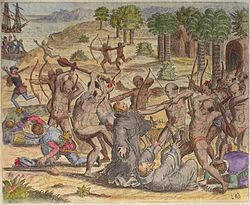Theodor de Bry
The Spanish Inquisition forced de Bry,[citation needed] a Protestant, to flee his native, Spanish-controlled Southern Netherlands.
Most of his books were based on first-hand observations by explorers, even if De Bry himself, acting as a recorder of information, never visited the Americas.
The art of copper plate engraving was the technology required at that time for printing images and drawings as part of books.
Between 1585 and 1588 he lived in London, where he met the geographer Richard Hakluyt and began to collect stories and illustrations of various European explorations, most notably from Jacques Le Moyne de Morgues.
He and his son John-Theodore made adjustments to both the texts and the illustrations of the original accounts, on the one hand in function of his own understanding of Le Moyne's paintings, and, most importantly, to please potential buyers.
In addition to day-to-day life of the American natives, Theodore de Bry even included a few depictions of cannibalism; largely thanks to the accounts of Amerigo Vespucci this was already a very common element in images showing a personification of the Americas.
In Argentina, it is possible to find copies at the Museo Maritimo de Ushuaia in Tierra del Fuego and at the Navy Department of Historic Studies in Buenos Aires.





